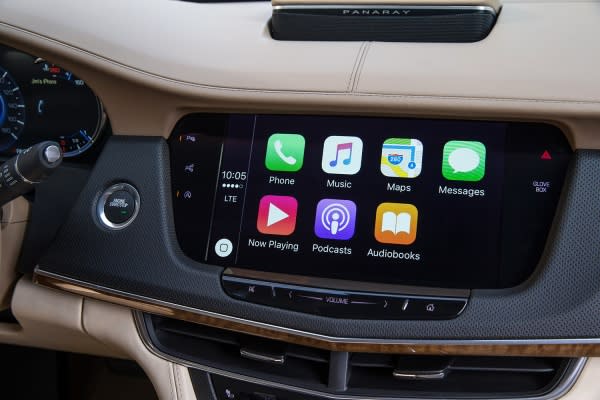Cadillac chief pans Apple's car interface
Everything in a Cadillac is supposed to be elegant. That must be why Cadillac’s president, Johan de Nysschen, is frustrated with the Apple CarPlay system that lets iPhone owners project some of their apps onto the digital screen in newer Cadillacs.
“There are a lot of things about this product I like, and other things that drive me absolutely nuts,” de Nysschen told Yahoo Finance at this year’s Detroit auto show. “It can bring a lot of functionality in the car, but I will also tell you it is extremely clunky.”
De Nysschen singled out Apple (AAPL) maps as a particular frustration. “Apple map data is still at the early stage,” he said. “It was not originally conceived for a vehicle traveling at 75 miles per hour. Like when it says turn left here—at the off ramp you have passed. That kind of stuff will need further work.”

The Cadillac boss also complained about balky transitions between CarPlay functions and those built into Cadillac vehicles. “There should be seamless switching of apps like Pandora or iHeart Radio,” de Nysschen said. “It doesn’t always really work that smoothly.” He gave one example: listening to satellite radio, which is one of the vehicle’s offerings, and then switching to Apple maps, via CarPlay, and using voice activation to input a command. When the voice command has been completed, the system is supposed to return to satellite radio. But there have been instances where the iPhone began playing music stored on the phone, essentially taking control of the screen. “I don’t know if Apple is doing it deliberately or not,” de Nysschen says. “But I’m calling them out.”
Apple is supposedly working on self-driving cars and other automotive technology, but CarPlay is its first foray into the automobile. On vehicles equipped with CarPlay—which must come preinstalled by the manufacturer–some iPhone apps can be accessed through the digital screen on the dashboard, once you plug the phone into the car’s charging port. Apple decides which apps operate through CarPlay, and it tends to favor its own apps over those of competitors. You can access Apple maps through CarPlay, for instance, but you can’t call up Google Maps or Waze, even if they’re on your phone.
Google parent Alphabet (GOOGL) has a similar product, called Android Auto, for Android phones. Most automakers support both systems on select vehicles, as long as the car comes with a touch screen. Consumers benefit because they can use some phone apps that might not be available on the car. A built-in navigation system, for instance, is typically an option costing $1,000 or more. But a smartphone interface gives an Apple or Android owner free mapping, right there on the dashboard.
Reviewers have pointed out imperfections in both systems, including the complexity of adding yet another menu of options to car infotainment systems that are already cluttered. And maps accessed through a phone usually aren’t as crisp or responsive as a built-in navigation system. In head-to-head comparisons, reviewers seem to favor Android Auto over CarPlay–partly because of better maps.
Auto executives sometimes vent privately about working with Apple, which is known as a demanding partner rigid about enforcing its own standards and reluctant to adopt anybody else’s. But it’s unusual for a senior executive such as de Nysschen to challenge Apple publicly. Engineers with Cadillac parent General Motors (GM) say Apple responds promptly to technical problems, typically fixing bugs through the regular software updates it pushes to iPhones. Yahoo Finance reached out to Apple, which did not respond on-the-record for this story.
Automakers in general have been reluctant to get too deeply involved with Apple or Google, worrying, for one thing, that the tech giants will go after consumer data that currently resides with the automakers. Big Tech clearly wants a piece of the $10 trillion in annual revenue the global car industry generates. Apple has a secretive on-again, off-again automotive unit, while Google has been fairly public about the self-driving technology it’s developing. Tesla CEO Elon Musk regularly predicts new breakthroughs at his own 11-year-old startup.
Auto executives express occasional frustration over the breathless press heaped on tech companies that have never built an automobile, or, if they have, have never turned a profit doing so. “I honestly do not believe there’s anything Google or Apple or anybody in Silicon Valley knows about the future of automotive capability that we don’t know,” de Nysschen said in Detroit. “We are as abreast of these new technologies as the fine men and women employed in all of those technology companies.” To prove otherwise, Apple and Google may just have to build their own cars.
Confidential tip line: rickjnewman@yahoo.com. Encrypted communication available.
Read more:
Rick Newman is the author of four books, including Rebounders: How Winners Pivot from Setback to Success. Follow him on Twitter: @rickjnewman
Follow Yahoo Finance on Facebook, Twitter, Instagram, and LinkedIn

 Yahoo Finance
Yahoo Finance 
